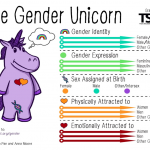This week, the American Academy of Pediatrics (AAP) is holding its annual leadership conference at its headquarters in Itasca, Illinois. One issue that won’t be on the formal agenda but will be on the minds of many members is how to treat gender dysphoria in children. AAP, along with most of America’s medical establishment, endorses the approach of the World Professional Association of Transgender Health (WPATH). This transgender advocacy group recommends that doctors irreversibly alter a child’s physical appearance to appear as a different gender through hormones and surgeries. But two transgender-identifying doctors in WPATH caution that teenage patients are receiving “sloppy care.” And there is dissent in AAP’s own ranks as to the legitimacy of this practice.
As many countries around the world turn to safer, non-invasive “watchful waiting” and psychotherapy to treat gender-confused kids instead of defaulting to hormones and surgeries, America is rapidly becoming an outlier. Now former patients (known as “detransitioners”), with the support of whistleblowers, are filing medical malpractice lawsuits and testifying in support of legislative limits on administering these experimental procedures to children. The architects of pediatric gender transition have built their arguments on flimsy evidence and the reputations of prestigious groups instead of objective, sound science. Their house of cards is starting to collapse.
Politicized Standards of Care
Gender dysphoria is a mental disorder that creates incongruence between one’s internal sense of gender and the reality of the sexed body. But unlike with anorexia, AAP’s recommended treatment does not focus on resolving the mind-body incongruence through counseling. Instead, doctors at “gender clinics” try to make a person’s body resemble their self-perception, disordered though it may be. Recently, 21 doctors from nine countries raised concerns that the American medical establishment has adopted “politicized” standards of care.
Start your day with Public Discourse
Sign up and get our daily essays sent straight to your inbox.This isn’t the first time this has happened. Back in the twentieth century, another radical ideology captured the scientific and medical establishment. Eugenicists persuaded doctors to sterilize 70,000 Americans, who were disproportionately women and minorities. Medical schools taught eugenics. Wealthy tycoons funded the practice. And three presidents (Theodore Roosevelt, Franklin Delano Roosevelt, and Woodrow Wilson) lent their political support. The support for eugenics also existed on a systemic level: The American Neurological Association endorsed forced sterilization of people with schizophrenia, manic depression, epilepsy, and Down syndrome, and the American Medical Association relied on the research of a wealthy eugenics advocate for its contraceptive testing. Eventually, the premise of eugenics, genetic inheritance, was debunked and discredited by scientific evidence. But for three decades, doctors participated in one of the greatest ethical scandals of the last century.
Legal Endorsement of Eugenics and Growing Skepticism
Sadly, courts also enabled doctors to use their licenses, credentials, and skills to carry out experiments in eugenics on their patients. In the 1927 case Buck v. Bell, the U.S. Supreme Court upheld a Virginia law that allowed an 18-year-old woman, Carrie Buck, to be sterilized against her will. After Buck reported that she became pregnant through rape, her foster parents committed her to an institution for the “feebleminded.” Doctors sought to sterilize Buck on the grounds that it would eliminate an unfavorable trait from the population. In an infamously cruel endorsement of eugenics, Justice Oliver Wendell Holmes, Jr., declared, “Three generations of imbeciles is enough.”
For three decades, doctors participated in one of the greatest ethical scandals of the last century.
The legal battle against eugenics reached a turning point when the U.S. Supreme Court recognized a prisoner’s human right to have children. In the 1942 case Skinner v. Oklahoma, the court rejected efforts to forcibly sterilize an inmate on the grounds that it violated the Constitution’s equal protection clause. Advocates for the disabled finally brought an end to eugenics in America by persuading state legislatures to pass “white cane laws” to protect the disabled from discrimination. The wave that began in state legislatures culminated in Congress’s passing the Americans with Disabilities Act in 1990. These laws made involuntary sterilization effectively unlawful and culturally unthinkable.
But, in a tragic echo of this dark moment from America’s past, some U.S. courts are now greenlighting a course of irreversible treatment for confused, vulnerable youth that would potentially render them sterile, often with a raft of lifelong medical complications and mental health challenges.
Fortunately, a contingent of courageous doctors is working to stop history from repeating itself. These doctors have repeatedly tried to introduce resolutions in the AAP calling for systematic evidence reviews, the gold standard in medicine. AAP leadership has ignored them even though one resolution questioning support for gender transition garnered 80% support from those who voted.
In a tragic echo of this dark moment from America’s past, some U.S. courts are now greenlighting a course of irreversible treatment for confused, vulnerable youth that would potentially render them sterile, often with a raft of lifelong medical complications and mental health challenges.
Conscientious objectors in the AAP point to Europe’s U-turn on surgical and hormonal interventions. After England, Sweden, and Finland conducted systematic evidence reviews, they determined that there is no reliable evidence that such interventions are medically safe (in fact, the reviews document substantial bodily harm to these minors), nor that they actually relieve psychological distress in children over the long term. If anything, many of these children have pre-existing mental health issues that gender transition can exacerbate. For instance, in Sweden, the media drew attention to a woman who hanged herself after undergoing gender transition surgery. One clinic refused to treat her, citing signs of schizotypal personality disorder, but another went ahead. A study that followed adults for 10 to 15 years after surgical transition also found that they were 19 times more likely to die by suicide than their comparable peers. All three countries now recommend only non-invasive psychotherapy and counseling in almost all cases for children who suffer from gender dysphoria or claim a transgender identity.
Doctors are also concerned that social contagion is driving the “new” gender dysphoria. In England, the number of girls identifying as transgender skyrocketed by 4,400% in a decade. And according to one study, the number of American youth diagnosed with gender dysphoria nearly tripled over a recent five-year period. If children experience gender dysphoria before puberty, there is a very strong possibility they will become comfortable with their bodies if doctors don’t interfere with their development. By contrast, a Dutch study of children who were treated with puberty blockers showed that 93-98% went on to receive cross-sex hormones. While doctors touted it as evidence of a correct diagnosis, medical experts point out that the puberty blockers may have solidified feelings of gender dysphoria that otherwise might have diminished.
Instead of fostering serious, objective scientific inquiry and heeding concerns from within their own ranks, the establishment continues to rely on WPATH’s guidelines for dealing with gender dysphoria. And contrary to sound inquiry, WPATH cherry-picked studies instead of conducting a systematic review of the best available evidence. As one member of the Endocrine Society recently wrote about its guidelines, “the society’s full-throated endorsement of gender-affirming care implied condemnation of anyone who holds differing views.” This cows doctors into silence and coerces them into providing dangerous interventions to children.
Instead of fostering serious, objective scientific inquiry and heeding concerns from within their own ranks, the establishment continues to rely on WPATH’s guidelines for dealing with gender dysphoria.
The House of Cards is Falling
Carrie Buck had no voice of her own within the justice system. Her lawyer at the Supreme Court was a close friend of the eugenics advocate who sought to sterilize her. And at a time before social media, she had no voice in the public square. But today, former patients are speaking up about the medical system’s failure to protect them.
In England, Keira Bell’s medical malpractice lawsuit against the Tavistock clinic raised awareness that teenagers lack the capacity to give informed consent. After only three one-hour appointments, doctors put Bell on puberty blockers at age 16, then performed a double mastectomy at age 20. In assessing what was driving Bell’s mental distress, they dismissed her depression and her mother’s alcoholism and mental illness. Bell said she couldn’t understand the risks and now worries that she will never be able to have children.
In California, Chloe Cole filed a medical malpractice lawsuit against her doctor and Kaiser Permanente, claiming doctors ignored her mental health issues, including the trauma of sexual assault. Instead, they prescribed her puberty blockers at 13, then began testosterone injections and performed a double mastectomy, all before she was 17. In less than a year, she began to regret the permanent loss of the ability to breastfeed. Cole’s lawsuit states that doctors hid the harms of these interventions and the lack of long-term studies. Instead of disclosing the strong possibility that gender dysphoria could resolve naturally, doctors told her parents that without this radical regimen, their daughter would be more likely to commit suicide. Cole recently testified before Congress, asking it to end “the largest medical scandal in history” to prevent other youth from becoming victims of pediatric gender transition.
Whistleblowers on both sides of the Atlantic are confirming medicine’s betrayal of young patients. In Missouri, Jamie Reed says Washington University’s gender clinic did not allow her to schedule patients for psychological care even though they had autism, ADHD, depression, and anxiety. Reed says the clinic lied to both patients and their parents. And at Tavistock, psychiatrist David Bell says leadership treated him with hostility when he raised concerns about the medical transition of children as young as eight. Bell says, “What matters is the truth. I hate the weaponisation of victimhood, the fact that the fear of being seen to be transphobic now overrides everything. . . It’s about free thinking, the kind that will result in better outcomes for all young people, whether transgender or not.”
As more stories like these surface, doctors who performed pediatric gender transition are now being held to account by former patients-turned-advocates. Since 2021, more than 20 legislatures have enacted laws to protect children from the irreversible harm these procedures can cause. Detransitioner Prisha Mosley, for example, recently filed a medical malpractice lawsuit for pediatric gender transition surgery that left her in constant pain and fearful that she is sterile. Yet the AAP and other medical organizations continue to turn a deaf ear toward stories like hers and the growing evidence against these procedures. Instead, they oppose legislative limits that protect children from irreversible harm. Some judges have sided with them and enjoined laws in Arkansas, Alabama, and Florida. But recently, the U.S. Court of Appeals for the 6th Circuit issued a decision upholding Tennessee’s law protecting children from medical transition. The court rightly concluded that it is the role of the legislature—not the courts—to determine whether such procedures should be available to children.
The medical establishment’s complicity with the eugenics movement of the last century should have led to serious evidence-based inquiry before subjecting another vulnerable population to irreversible harm; however, the country’s leading doctors are embracing ideology and eminence over scientific evidence and sound ethical principles as much now as in the age of Buck v. Bell. But, under the weight of scientific evidence, international skepticism, and firsthand testimonies from former patients, their house of cards is tumbling down. For the sake of gender-distressed children, their parents, and their potential progeny, it can’t happen a moment too soon.














